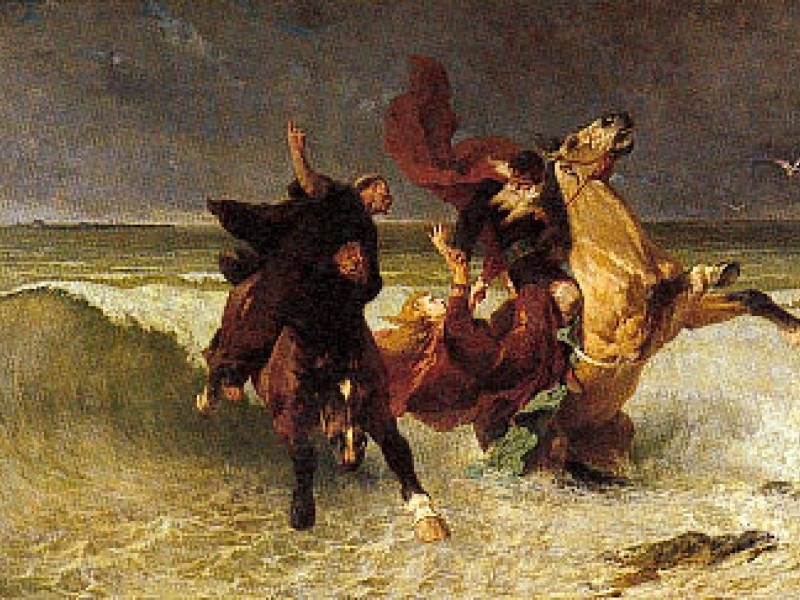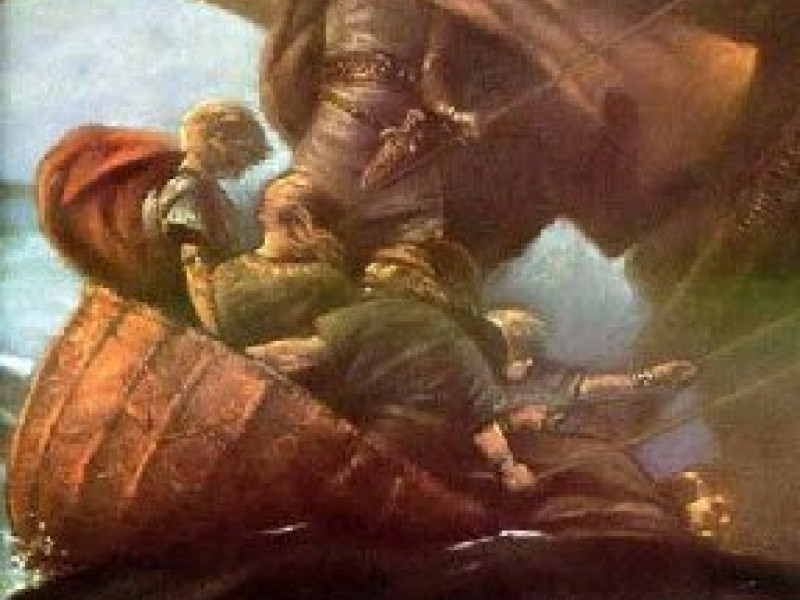City of Ys
There have been several legends of a city or civilization that was wiped out by a flood or tidal wave, never to be seen again except through long forgotten lore. The earliest was that of Atlantis, which a philosopher of the 4th century BC, named Plato, had first written about in his two dialogues: Timaeus and Critas. Then during the medieval period, there was the lost kingdom of Lyonese or Leonois, the home of the Celtic hero Tristan (Tristram).
However, nothing was more inspiring than the city of Ys, a city that disappeared off the southwest coast of Brittany. The legend indicated that it sank into the Bay of Douarnenez. Ys was the city of Gradlon the Great and the princess Dahut.
Born of the Sea
Gradlon was the king of Armorica (Brittany), well at least the ruler of the westernmost kingdom.
According to one version, Gradlon fell in love with a sorceress/druidess (or even fairy woman) who followed the old, pagan religion. At first they were happy together until the King met St Guénolé, and was baptised and became a Christian. This angered his wife, who decided to leave him.
Gradlon, who still loved her, followed her, pleading with her not to abandon him. When she crossed the river, she warned that he would die if tried to cross. Heedless of her warning, Gradlon tried to wade across the deep, swift-flowing stream. The King would have drowned, but the woman saved him, proving that she was still in love with him. She stayed with him long enough to become the mother of Dahut. In some legends, she was called Ahes.
This crossing the stream and being saved by the woman, was similar to a Breton lai, titled Graelent. However, in this tale, there was no Dahut and no city called Ys.
Another version which was quite popular said that the beautiful sorceress was named Malgven, who was already married to an old King of Sjælland (island of Denmark) by the name of Sverðlun. Malgven seduced the young Gradlon to become her lover. Together, they conspired to have Sverðlun murdered. Gradlon drove his sword through Sverðlun's body as he slept. The two lovers then fled.
It was while they were drifting at sea when Malgven became pregnant and then died after giving birth to a daughter, while on board the ship. Gradlon named her Dahut (Dahud) or Ahé (Ahés).
Yet another version said that Gradlon had met Malgven in Alban (Scotland), the land of the Picts. Gradlon brought her back with him to Brittany, along with his magical horse, Morvarc'h. Morvarc'h had the wondrous ability to travel on the surface of sea, as if the steed were running on dry land.
Key to Destruction
Dahut grew into a beautiful young woman, and her father was quite besotted with her. Like his mother, Dahut followed the old pagan religion rather than the new religion, Christianity. Either Gradlon built the city in honour of Malgven or Dahut, or his daughter asked him to build the city so that she could be near the sea or to avoid persecution from Christians.
Whatever was the cause of the city's construction, it was the most beautiful city in the world, with great white palaces and temples to the old gods. The city was called Kér Is or simply as Ys. Because of the location, the city thrived, because it became the centre of trade. Wealth and luxuries were pouring into Ys.
But Ys was located in low-lying land, so Gradlon constructed tall dikes to protect his capital from the unpredictable sea. There was a bronze door or floodgate which only he had the key to. The gold key was attached to his necklace. A different version says that the city was protected by a magical oak tree.
One person who was against the riches and luxuries was St Guénolé, who denounced the people as wicked, including Gradlon's own daughter. Guénolé accused Dahut of following the old religion, and of leading the people into sin through nightly revelries and debauchery.
There are a number of different accounts about how the city was destroyed.
The earliest account says that Dahut and her lover were drunk, when she stole the key to the dikes so that the entire city became submerged in the water. Dahut died along with countless people of Ys.
Another account says that a boy named Kristof caught a magical fish, using a stick and a stone. This fish would have given Kristof anything he wished for, in return for its liberty. Dahut scornfully laughed at this exchange, so the fish used its magic so that the princess became pregnant. Kristof angrily stole the enchanted oak tree which protected Ys.
One night, Dahut met a red knight who offered his love to the princess. The red man told her to steal her father's key for him. With the key, he opened the dikes, letting the sea engulf the city. This man was said to be the Devil himself.
Guénolé woke the king, telling him to flee. Gradlon got on his horse Morvarc'h and tried to gallop to safety. Dahut cried out to her father to save her. Seeing his daughter running for her life, Gradlon took his daughter onto his horse and rode as hard as he could. Morvarc'h should have easily brought them all to safety, but tonight Gradlon found that Morvarc'h could not outrun the rising water.
Guénolé urged the king to fling the princess aside, since she was the cause of the city's destruction. Gradlon refused to sacrifice his daughter. However, when the water was reaching the level of his waist, the voice of God ordered Gradlon to "cast aside the fiend". Gradlon sorrowfully obeyed and flung his daughter into the water. The water immediately receded so that he managed to safely reach the hill outside of city.
However, Ys was completely engulfed, and now Ys became the Bay of Dourarnenez. Gradlon left his capital and headed southeast, where he settled in Quimper.
Dahut, though, did not die. Dahut was transformed into a sea-sprite or mermaid, where she was sometimes seen sitting on a rock brushing her long beautiful hair. Like the Sirens, her voice lured sailors to wreck their ships on rocks.
As for the city of Ys, when the tide was particularly low, some of the high towers could be seen below the surface. Bells from the beautiful cathedral could sometimes also be heard.
By Jimmy Joe




